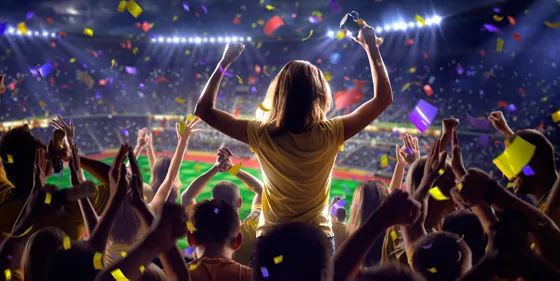Your Genesys Blog Subscription has been confirmed!
Please add genesys@email.genesys.com to your safe sender list to ensure you receive the weekly blog notifications.
Subscribe to our free newsletter and get blog updates in your inbox
Don't Show This Again.

Whether it’s a majestic view of a skyline or waterfront, the best hot dog or a cutting-edge lighting system, there’s nothing like being at one of the world’s top stadiums. From MLB games to the Premier League, sports stadiums all over the world are rethinking how they create an experience for fans and placing a lot of emphasis on new technologies to build the best customer experience.
“Upgrading the telephony and data backbones of stadiums and ballparks has been going on for decades, but now this is being extended to upgrading customer service in such a way that it transforms the fan experience through technology,” Nancy Jamison, digital transformation principal analyst for Frost & Sullivan.
Here we take a look at the five stadiums with the most innovative mobile customer experience.
At Marlins Park in Miami, 225 access points power the stadium wide Wi-Fi network. Over the network, fans can use mobile tools such as the Major League Ballpark App, now available in all baseball stadiums. The ballpark provides customer experience optimization by allowing fans to check in using iBeacon technology and receive targeted offers and rewards on smartphones. The app also allows fans to upgrade their seats and follow players’ entrance music and purchase the songs on iTunes. Fans can also share photos as well as order food through the app and have it delivered to their seats.
To add to the fun, the stadium features two 450-gallon tanks with nearly 100 tropical fish. You’ll also find a pool and a 73-foot marlin sculpture that rotates when a Marlin player hits a home run.
As part of its tech overhaul, London’s Wembley Stadium has implemented 400Mbps 4G+ connectivity from EE to allow fans to stream goal replays, check sports apps and share photos and videos on social media. At Wembley, fans are able to watch replays of goals on their phones using the app within seconds after a play. Fans can also order food on their phones and have it delivered to their seats. In addition, the iconic arch at Wembley shares fans’ social media feeds and reactions to moments such as when goals are scored. Fans can also check out the view from the arch cam using the Wembley mobile app.
Home to the FC Bayern München and TSV 1860 München football teams, Allianz Arena has a visually impressive exterior made of Asahi Glass’s fluoropolymer technology, making the facility look like a blimp. It features a Philips system that illuminates more than 300,000 LED lights over a surface area of 26,000 square meters.
An SAP Process Orchestration platform allows stadium employees to make it easier for fans to find a parking space. The staff collects data from parking garages, stadium entrances and cashier systems, allowing the venue to maintain shorter lines at these locations. SAP’s HANA consolidates and processes the data so arena staff can view it in the Allianz Arena Alerting mobile app. “Thanks to SAP Process Orchestration, we can collect data from various systems in and around the stadium on game days,” said FC Bayern CIO Michael Fichtner. “We now know exactly what’s going on in real time. This helps us deliver the best possible experience to our fans when they visit the Allianz Arena.”
U.S. Bank Stadium, home of the Minnesota Vikings NFL team, opens in August with 12,560 total square footage of video boards compared with 646 feet for its predecessor, the Metrodome. U.S. Bank Stadium uses beacons to provide location-specific information to a mobile app. Designed by VenueNext, the app will provide info on traffic, parking concessions and restroom lines. U.S. Bank Stadium will be the first American stadium to feature ethylene tetrafluoroethylene (TTFE), a tear-resistant film that will allow it to deliver natural light and still protect fans from the elements.
The stadium also features two 92-square-meter giant television screens of 150,000 pixels. In addition to supporting 70,000 fans during soccer games, the facility has a 6,000-square-meter space for shopping, conference rooms and exhibitions.
Home to the San Francisco 49ers and the site of Super Bowl 50 in 2016, Levi’s Stadium incorporates Bluetooth Low Energy beacons to provide key information to fans’ smartphones, including which restrooms have the shortest lines. The beacons also offer customer experience optimization by directing fans where to park and helping to guide them to their seats. The stadium uses 400 miles of cabling, and a 40-gigabit Wi-Fi connection streams stats and instant replays to customers’ smartphones and tablets to create a personalized experience. “It is an amazing difference from other venues, which make it difficult to tweet or see anything live because there isn’t enough bandwidth,” Jamison said.
The Levi’s Stadium app allows fans to order food beverages and have them delivered to their seats. The app also provides a “game center” of high-definition video replays from four different camera angles. Fans get mobile customer service by contacting app specialists called “The NiNerds” from within the app. And for those environmentally conscious sports fans, Levi’s Stadiums is also one of the most sustainable stadiums (which goes a long way with the millennial crowd).
“We built this stadium based on three pillars,” Al Guido, the 49ers’ chief operating officer, told CNET. “Technology, sustainability and the fan experience.”
With their variety of food options, high-tech screens and Internet connectivity, stadiums have evolved over the years to keep fans engaged. And as new technology continues to spur new innovation, the future of the sports stadium experience promises to be an exciting one.
Read more about how mobile customer engagement can enhance your experience, Frost & Sullivan—Mobile Engagement Delivers Great Customer Experiences.
Subscribe to our free newsletter and get blog updates in your inbox.